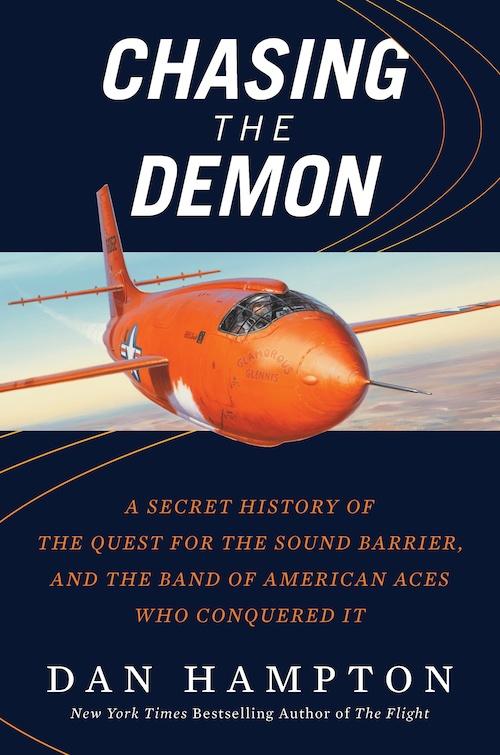Air Force veteran and best-selling author Dan Hampton ("Viper Pilot," "Lords of the Sky") returns with "Chasing the Demon: A Secret History of the Quest for the Sound Barrier, and the Band of American Aces Who Conquered It," which out now and available for purchase here.
"Chasing the Demon" digs deep into the military's race to achieve supersonic speeds in the years after World War II. The "demon" was the nickname test pilots gave to the sound barrier. The story that Hampton's uncovered is far more complicated and interesting than the version you may know already.
We've got an excerpt from the book courtesy of William Morrow, an Imprint of HarperCollins Publishers. It's taken from the preface and it does a great job of setting up the story.

Excerpt from: CHASING THE DEMON by Dan Hampton
During that brief flight in 1945, Lothar Sieber did indeed become the first man to be successfully launched in a rocket—for fifty-five seconds. At 1,650 feet, some fifteen seconds into the flight, the canopy inexplicably detached and the Ba-349 flipped onto its back while climbing shallowly to 5,000 feet. Rolling inverted, the Natter then dove straight into the ground about four miles from its launch point, barely missing the little hamlet of Stetten am kalten Markt. A partial left leg, a left arm, and fragments of Sieber's skull were eventually recovered from the fifteen-foot-deep crater.
No one knows exactly what occurred that morning, yet when the canopy detached, it could have struck Sieber. A pilot's conscious or semiconscious reaction would be to grab the stick and pull back, so if this occurred the Natter would have ended up on its back. Entering a cloud deck at that speed and attitude would be disorienting, and Sieber would very likely find himself out of control. If this happened, he would try to bail out, though this would be nearly impossible in a 500 mph dive. The fact that his left leg and arm were recovered lends credence to this notion, however, and he may have been trying to climb out of the tiny cockpit when the Natter impacted.
No matter the cause, with the failure of this single manned flight, and with Allied forces converging on the Germany from all sides, a secret list of top German scientists and engineers was passed to U.S. intelligence. With the war ending, the Americans initiated Operations Lusty and Paperclip to prevent this equipment, these men, and their special knowledge from falling into Soviet hands. Over 1,500 were eventually relocated to the United States, including Major General (Dr.) Walter Robchasing ert Dornberger, who would eventually become the vice president of Bell Aircraft.
The Natter project was discontinued, yet there are those who were present as Sieber's Natter shot from the clouds, rocket motor screaming at 600 miles per hour and accelerating, who claim they heard the demon's voice: a boom that would later be recognized as flight past the speed of sound.
Six weeks later a man felt the demon's claws and got close enough to smell its breath. On April 9, 1945, two sleek Me 262 Schwalbe jet fighters lifted off from Lechfeld, just west of Munich, and headed up into thin, clear air. Led by Lieutenant Colonel Heinrich Bär, a Luftwaffe experten with over 1,000 combat sorties and 220 confirmed victories, the jets leveled off at 36,000 feet. Today was a training mission for Bär's wingman, Hans Mutke, who was converting to the Me 262 after three years of flying Bf 110 night fighters.* The Schwalbe, or "Swallow," was now Germany's last realistic hope to alter the drastic situation in the skies over the Reich. Powered by a pair of Junkers Jumo engines, each producing 4,000 pounds of thrust, the Messerschmitt could climb at 3,900 feet per minute and sustain 532 miles per hour in level flight at 26,000 feet. The armed variant usually carried four 30 mm cannons, and twenty-four 55 mm rockets capable of hitting a B-17 from a half mile away. It was a game changer and, if not a war winner at this late stage in the conflict, there still were those who believed it was still not too late, which was why experienced, twin-engined pilots like Mutke were being rushed through the conversion course.
"He's under attack . . . right now."
Bär's voice was calm as he rolled over and dove his armed Me 262 left toward a P-51 attacking another German fighter far below. Mutke followed in his unarmed jet with no external tank. Though a highly experienced pilot, this was only his third jet sortie and, as one would in a piston-engined fighter, Mutke left the throttles up. Passing about 35,000 feet in a 40-degree dive, the jet began bucking wildly, and the tail began to yaw. Obviously alarmed, he noticed the airspeed indicator was pegged at the limit of 1,100 kilometers per hour: about 680 miles per hour. As his nose pitched sharply down, Mutke could no longer control the 262, later recalling to American aviation historian Walter J. Boyne: "I moved the stick wildly around the cockpit. For a brief moment, the airplane responded to controls again momentarily, then went back out of control. The plane still did not respond to pressure on the stick so I changed the incidence of the tailplane. The speed dropped, the aircraft stopped shaking, and I regained control."
By manually altering the angle of the horizontal tail, which could be done from the cockpit, Mutke disturbed the airflow over his stabilizers and slowed from supersonic to subsonic speed. When this occurred, the shock wave generated by supersonic air moved forward, allowing the nose to lift again and control to be restored. Mutke was able to throttle back, which flamed out his engines, then slow to a controllable 300 miles per hour. Managing to land, he and the ground crew discovered popped rivets and warped wings.
Limited to 0.86 Mach by technical order, it was physically possible for the Me 262 to exceed the speed of sound in any sort of dive. At full throttle in the thin air above 30,000 feet and diving, this becomes more likely if there is no structural failure. The damage to Mutke's jet indicates that any sort of prolonged flight under those conditions would have been disastrous. A computer-modeling simulation conducted at the Technische Universität München in 1999 suggested it could be done—but a simulation is not the real thing.
Did it happen?
Ken Chilstrom, one of the original USAF test pilots who flew a captured 262, doesn't think so. "The engines could have done it," he stated in a 2017 interview for this book, "but structurally I don't think the plane would have held together."
"This could have just been the jet I flew though," he added. "German quality was very problematic at that phase of the war, and each jet was put together a bit differently."
No one knows, and to date nothing has been found in Messerschmitt's surviving wind tunnel data to indicate it had ever been tried. Yet given the combat accidents suffered by Allied fighter pilots who lost control during high-speed dives, transonic speeds had clearly been reached. And if straight-winged, piston-engined aircraft could cross into that region, then a swept-winged jet certainly could so.
How then did mankind, who had only truly flown forty-two years earlier, progress to the point where flight past the speed of sound was possible? For even if it did not occur on that March day in 1945, it was certainly possible, and extreme velocity was the way of the future. This was a hard lesson learned on both sides as jet-powered Me 262's operated far beyond the capabilities of Allied piston-engined fighters and defensive guns from bomber formations. Fortunately, there were too few of them to make a significant impact, but this same German technology, inherited by the Allied victors, would live on to shape global geopolitics during the late 1940s and early 50s.
With the atomic bombing of Hiroshima and Nagasaki at the end of World War II, the nuclear age had begun. War planners now faced a radically new calculus: the ability to get a bomb over target faster than one's enemy trumped "conventional" tactics. Meanwhile, a new conflict, the Cold War, was emerging. Tensions between the United States and the Soviet Union were already high as the fragile, wartime alliance frayed to a point where, in 1946, Joseph Stalin openly declared the coexistence of capitalism and socialism to be impossible. Justifiably wary of challenging the American military, Soviet engineers and scientists raced to close the technical gap. Jet aircraft, specifically long-range strategic bombers capable of delivering nuclear weapons, were initially viewed as the best option for power projection. This, Moscow believed, would permit the intimidation possible for multi-hemispheric, Communist expansion and, if the situation deteriorated, would provide a Soviet capability to wage open war with the United States.
Equally cognizant of the military and ideological threat posed by the USSR, American leaders were determined to maintain their technological edge and therefore blunt Communist ambitions. If atomic or thermonuclear warheads could be delivered onto an enemy's soil, as had been done against the Japanese, then who would risk armed confrontation with the United States?
Even as they returned home to try to enjoy a world without war, a small group of incredibly daring American fighter pilots were poised to shake the foundations of man's achievements to their core; to kick open the door of modern air combat tactics and change the world as it currently existed. Having survived combat and vanquished one set of threats these men knew other evils would rapidly emerge to fill the vacuum, and so they did. Ideological and nuclear threats capable of a mass destruction unthinkable a decade earlier, and for a few short years the safety of the world was dependent on an extremely narrow margin defined and redefined by military technology; an anthropogenic Pandora's Box that could either be contained by the West, or opened by the East through the possession of a single key: speed.
In the years immediately following World War II speed was the yardstick by which aircraft, the "long rifle" of the modern age, were measured. Before the development of intercontinental or submarine-launched ballistic missiles, jet aircraft capable of high subsonic flight were essential to the ambitions of both superpowers, and to the making of war or the preservation of peace. The ability to fly farther, longer, and, above all, faster, could either balance or tip the uneasy strategic equilibrium of the postwar era. Manned supersonic flight was the prize as it offered an area of exclusion—a profound combat advantage—for those who possessed it against those who did not. This quest began with experimental aircraft and fighters, for a supersonic interceptor could destroy a bomber well before it could drop its lethal, thermonuclear payload. Defensive weapons, coupled with radar guidance, had not yet been developed to counter such speed, so it was believed that such combat operations could be conducted with relative impunity, and thereby ensure victory or maintain the peace.
Men like Ken Chilstrom, George Welch, Chalmers Goodlin, and Chuck Yeager had already risked everything for their country during the Second World War; their own lives had been disrupted and forever altered, yet they did not hesitate to roll the dice again in the name of duty, danger, and honor. These were hardened men born in the turmoil following the Great War, raised to maturity during the chaos of the 1930s, and honed sharp by combat. They understood, if others did not, that peace not backed by strength was an empty hope. These men were part of an America that accepted, albeit reluctantly, a mantle of global leadership that could not be discarded if the world were to remain safe for their children's children. Just as it never occurred to them to dodge their wartime obligations, they could not, and would not, shrink from a new challenge. Only pilots such as this could chase the demon beyond whatever barrier existed, and finally take mankind faster than the speed of sound.
* Mutke remained a fahnrich, an officer cadet, all through the war because he would not join the Nazi Party. Surviving the war, he finished medical school and became a gynecologist.





